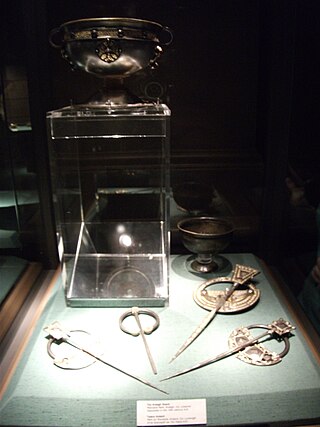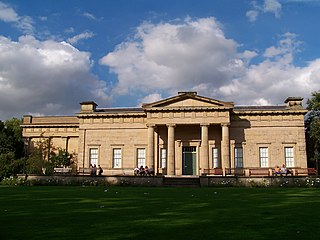
Bronze is an alloy consisting primarily of copper, commonly with about 12–12.5% tin and often with the addition of other metals and sometimes non-metals, such as phosphorus, or metalloids, such as arsenic or silicon. These additions produce a range of alloys that may be harder than copper alone, or have other useful properties, such as strength, ductility, or machinability.

A crucible is a container in which metals or other substances may be melted or subjected to very high temperatures. Although crucibles have historically tended to be made out of clay, they can be made from any material that withstands temperatures high enough to melt or otherwise alter its contents.

Knaresborough is a market and spa town and civil parish on the River Nidd in North Yorkshire, England. It is three miles east of Harrogate and was in the Borough of Harrogate until April 2023.

Repoussé or repoussage ( ) is a metalworking technique in which a malleable metal is shaped by hammering from the reverse side to create a design in low relief. Chasing or embossing is a similar technique in which the piece is hammered on the front side, sinking the metal. The two techniques are often used in conjunction.

The Ardagh Hoard, best known for the Ardagh Chalice, is a hoard of metalwork from the 8th and 9th centuries. Found in 1868 by two young local boys, Jim Quin and Paddy Flanagan, it is now on display in the National Museum of Ireland in Dublin. It consists of the chalice, a much plainer stemmed cup in copper-alloy, and four brooches — three elaborate pseudo-penannular ones, and one a true pennanular brooch of the thistle type; this is the latest object in the hoard, and suggests it may have been deposited around 900 AD.

Niello is a black mixture, usually of sulphur, copper, silver, and lead, used as an inlay on engraved or etched metal, especially silver. It is added as a powder or paste, then fired until it melts or at least softens, and flows or is pushed into the engraved lines in the metal. It hardens and blackens when cool, and the niello on the flat surface is polished off to show the filled lines in black, contrasting with the polished metal around it. It may also be used with other metalworking techniques to cover larger areas, as seen in the sky in the diptych illustrated here. The metal where niello is to be placed is often roughened to provide a key. In many cases, especially in objects that have been buried underground, where the niello is now lost, the roughened surface indicates that it was once there.

The quoit brooch is a type of Anglo-Saxon brooch found from the 5th century and later during the Anglo-Saxon settlement of Britain that has given its name to the Quoit Brooch Style to embrace all types of Anglo-Saxon metalwork in the decorative style typical of the finest brooches. The brooches take their modern name from the rings thrown in the game of quoits, and have the form of a broad ring, or circle with an empty centre, usually in bronze or silver, and often highly decorated. The forms are in a very low relief, so contrasting with other early Anglo-Saxon styles, with detail added by shallow engraving or punching within the main shapes. Dots or dashes are often used to represent fur on the animal forms, as well as lines emphasizing parts of the body. They are fixed with a single, straight hinged pin like those of other Anglo-Saxon ring or Celtic brooches and are further defined by the presence of a slot and pin-stops on the ring.

Farnham is a village and civil parish in the Harrogate district of North Yorkshire, England. It is situated 2 miles (3.2 km) north of Knaresborough.

The Yorkshire Museum is a museum in York, England. It was opened in 1830, and has five permanent collections, covering biology, geology, archaeology, numismatics and astronomy.

The Guisborough Helmet is a Roman cavalry bronze helmet found in 1864 near Guisborough in the North Riding of Yorkshire, England. It was originally fitted with a pair of protective cheek-pieces, which have not survived; the holes by which they were attached can be seen in front of the helmet's ear guards. It is lavishly decorated with incised, punched and embossed figures, indicating that it was probably used for displays or cavalry tournaments, though it may well have been intended to be worn in battle as well. The helmet was found in what appears to have been a carefully arranged deposition in a bed of gravel, distant from any known Roman sites. After it was recovered during road works it was donated to the British Museum in London, where it was restored and is currently on display.

The Chaourse Treasure is a hoard of Roman silver found in Chaourse, a village near Montcornet, Aisne in northern France in 1883. Dating between the 2nd and 3rd centuries AD, the treasure is one of the most complete table services to survive from antiquity. This important hoard is now part of the British Museum's collection.

Anglo-Saxon brooches are a large group of decorative brooches found in England from the fifth to the eleventh centuries. In the early Anglo-Saxon era, there were two main categories of brooch: the long (bow) brooch and the circular (disc) brooch. The long brooch category includes cruciform, square-headed, radiate-headed, and small-long brooch brooches. The long brooches went out of fashion by the end of the sixth century.
Jennifer Foster is an English scholar of prehistoric and medieval archaeology, who specializes in the study of artifacts, particularly metalwork.

The Hexham hoard is a 9th-century hoard of eight thousand copper-alloy coins of the Anglo-Saxon Kingdom of Northumbria, which were discovered whilst a grave was being dug close to Hexham Abbey in 1832.

James Raine (1830–1896) was a British antiquarian and ecclesiast. He was a Canon and Chancellor of York Minster.

The Kirkoswald Hoard is a ninth-century hoard of 542 copper alloy coins of the Kingdom of Northumbria and a silver trefoil ornament, which were discovered amongst tree roots in 1808 within the parish of Kirkoswald in Cumbria, UK.

The Ryedale Roman Bronzes is an assemblage of Roman metalwork.
The St Leonard's Place hoard was a hoard of c. 10,000 early medieval Northumbrian coins known as stycas, discovered by workers during construction work at St Leonard's Place in York in 1842. Many of the coins were subsequently acquired by the Yorkshire Museum.
A number of Roman hoards have been discovered near Pewsey and Wilcot in the Vale of Pewsey, Wiltshire, England.
















